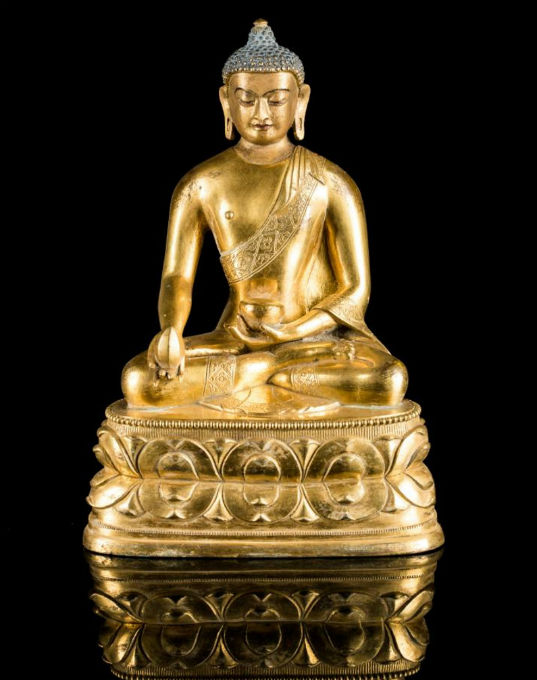
NEW YORK – The Indian prince Siddhārtha Gautama, born in the sixth century B.C. in the Himalayan foothills to become known as Buddha (or the Enlightened One), is reported to have said, “Better than a thousand hollow words, is one word that brings peace.” In the fourth and fifth centuries B.C., as a great age of intellectualism was sweeping the world (think Socrates, Plato and Confucius), the Buddha was transforming Indian philosophy and religion.
The Buddha is a key figure in Asian art. Early Buddhist art in India at first didn’t depict the Buddha as a man. Often, he was shown symbolically, sometimes as an empty throne, a Bodhi tree, a wheel, a riderless horse or a pair of footprints.
“In the first century A.D., the human image of one Buddha came to dominate the artistic scene, and one of the first sites at which this occurred was along India’s northwestern frontier,” according to a 2007 essay by Vidya Dehejia, Department of Art History and Archaeology, Columbia University, posted on the Metropolitan Museum of Art website. “In the area known as Gandhara, artistic elements from the Hellenistic world combined with the symbolism needed to express Indian Buddhism to create a unique style. Youthful Buddhas with hair arranged in wavy curls resemble Roman statues of Apollo; the monastic robe covering both shoulders and arranged in heavy classical folds is reminiscent of a Roman toga. There are also many representations of Siddhartha as a princely bejeweled figure prior to his renunciation of palace life.”
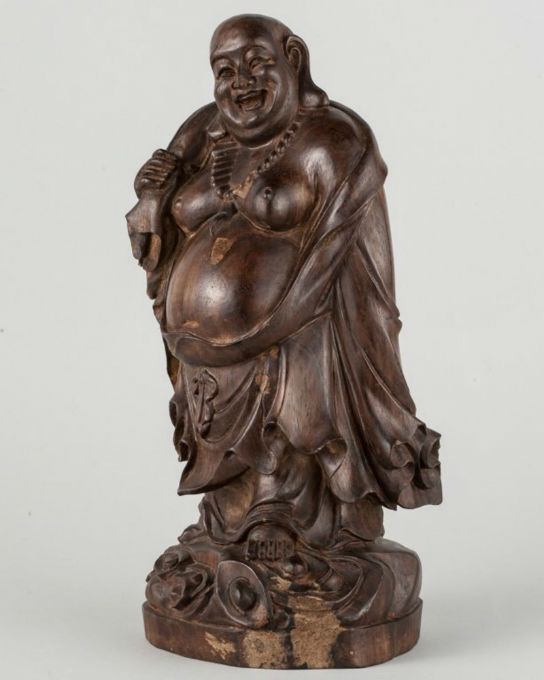
The 2015 exhibition, “Indian Buddhist Art from Indian Museum, Kolkata,” delved into the history of the Buddha in art, showing how Buddhist art traveled from India to other Asian regions and around the globe, changing to meld with the tastes of local cultures. “It is thought that Buddhist statues were first created in India in Gandhara and Mathura (northern India) at around the time of the Kushan dynasty (first to third century), which ruled an area of Central Asia from northern India in about the first century. Many of the statues of Buddha made shortly after the start of Buddhist sculpture are thought to have depicted the form of Sakyamuni. However, with the rise of Mahayana Buddhism, various other Buddhas were produced.”
Over the next few centuries, Buddhist art continued to develop in India, “flourishing in the Gupta period, also known as the golden age, which lasted from the fourth to the sixth century, according to Widewalls.com.
“Almost all of the works we can see today are religious sculptures, though the period saw the emergence of the Buddha figure and Jain Tirthankara figures. The Gupta period is significant for its creations of an “ideal image” of the Buddha, achieved through the combination of his traits from the region of Gandhara and the sensual form of Mathuran artists.”
Buddhist art is rich in symbolism and there is even a kind of visual code that is used to distinguish deities. “These features include color, gesture, pose, dress, and the holding of symbolic objects. At the sight of deities who are red, blue, white, yellow or green, the uninitiated viewer might marvel at what appears to be the artists’ freedom in the use of color, but that perception would be inaccurate,” according to an online survey of Tibetan Buddhist wall paintings of the Mustang district in Nepal, part of Brown University Library’s website. “Rather, the deities must be depicted according to the appearance proper to them, and with the proper features, each of these elements possessing a symbolic meaning. Thus, among the Dhyani-Buddhas, Ratnasambhava is always yellow, Amoghasiddhi always green. The Manushi-Buddha wears a patched robe and no ornaments, and the great Bodhisattvas are shown in royal dress, bedecked with ornaments.”
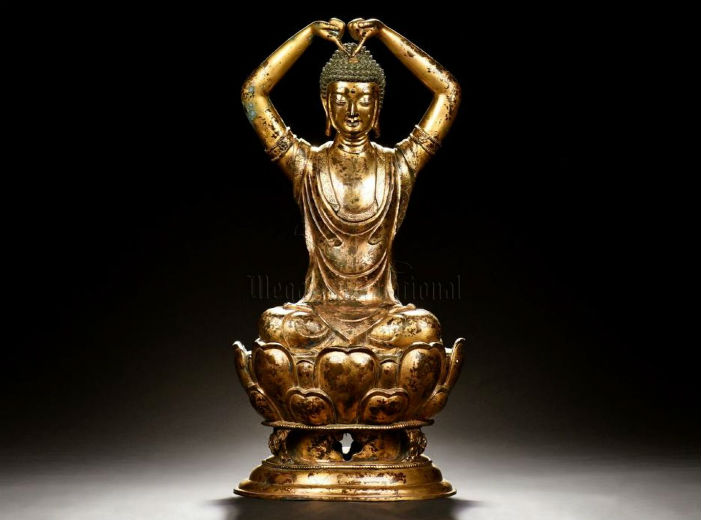
The deities also have a fitting kind of throne (a lotus throne, lion throne, a diamond throne.) and pictured a complementary ritual or symbolic object. Among Buddhist symbolism, a book stands for wisdom, an endless knot or mandala symbolizes eternal harmony, a lotus flower signifies purity, a sword is a weapon against ignorance, the wheel of Darma symbolizes knowledge, and a conch shell, the thoughts of the Buddha. Colors too are symbolic. White is purity, green is peace, yellow is prosperity, red is love, blue is knowledge or enlightenment and black symbolizes death.
The website for the Sabai Design Gallery in Australia says that traditional records of the Buddha indicate that when he experienced his spiritual awakening, he glowed with a radiance that spread to the world. “This light is expressed in art as a halo or aura of light called prabhamandala, depicted as circles of light. A fiery protuberance arising from the head in most sculptures of the Buddha is sometimes referred to as the flame aureole, a light burning with spiritual intensity.”
Rebecca Moss, Asian art specialist at New Orleans Auction Galleries, explained why the Buddha has become such a revered figure in Asian art from stone or metal (especially bronze) statue depictions to paintings. “As a concept that represents so much to so many, it is perhaps not surprising that the perceived likeness of the Buddha has been reverently depicted in various forms over the millennia. With about 10 percent of the global population identifying as Buddhist in some way, Moss said there are many countries and cultures that have large Buddhist populations with its influence felt in art and architecture throughout.
“In terms of art, China, Tibet, Japan and India are currently the most influential in the markets, but this needs to be looked at through the sphere of economic growth impacting market influence, rather than suggesting that certain countries revere the Buddha more than others in a religious or artistic sense,” she said.
In the auction market today, Chinese depictions are most prevalent and sought after, she said, “largely because the booming Chinese economy has pushed the buying power of Chinese collectors of art into the spotlight. Gilt-bronze representations appear to be the most desirable in terms of material at present, based on prices consistently realized, but specific porcelains and thangkas have also delivered strong results over the last few years.”
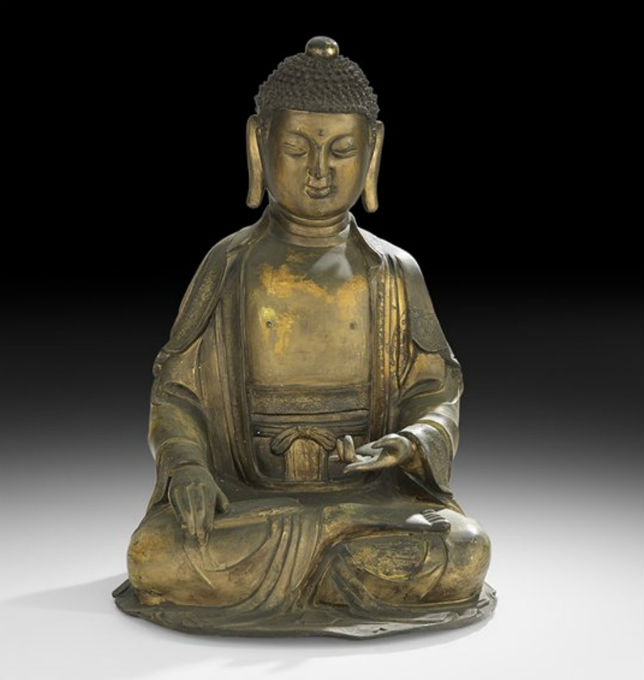
Tips on buying?
As with most, if not all works of art, provenance can be everything, Moss noted. “It can help verify not only the authenticity of a piece but can also confirm that it was legally brought to the United States, as many countries from which statues, thangkas and other representations of the Buddha are sourced have strict rules on the export of pieces after certain dates.”
“If you are looking to buy, always check your sources and try to establish provenance as far back as possible. Further to this, the market is awash with forgeries. Many are instantly recognizable by their poor quality, but there are some very good replicas out there that have even caught the experts out. My advice is to always see the piece in person, get a sense of its weight, its quality; look particularly to the smaller details such as the way the hands and feet are worked. Also look at the base and back, because, as these are areas often overlooked by forgers, they will often provide more clues about the piece.”
What makes one piece more desirable than another?
“Obviously condition is important, but look also to see if there are any inscriptions visible on the piece. Many bronzes created during the reigns of Chinese emperors, Xuande in particular, will bear a reign mark, and these early Ming works are some of the most sought-after pieces for collectors, earning some of the highest prices seen at auction,” Moss said.
“Outside of the elite sales, there is a wide spectrum of prices to be seen, based on quality, style, rarity and origin. Whether you are just starting out, or adding to an additional collection, always buy the best you can afford, but also buy something that speaks to you,” she said. “The depiction of Buddha was born out of a reverence that can be seen in the care put into each original creation; the serenity of a face, the graceful folds of a robe, the elegant pose of the hands, for, as the Buddha teaches, ‘Your work is to discover your world and then with all your heart give yourself to it.'”
The Asian Art Museum in San Francisco’s 2018 exhibition, “Divine Bodies,” was designed to encourage viewers to look at objects not just as pieces of art but as devotional images while pondering the question: “How can we see the human in the divine and the divine in the human?”
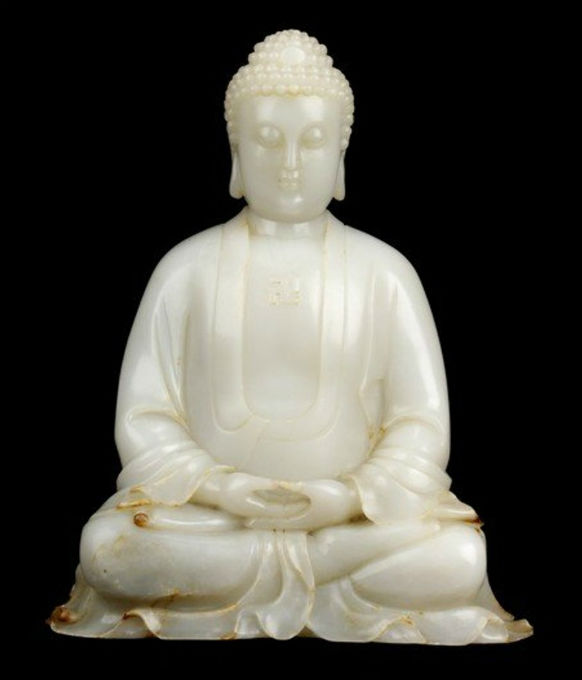
One section of the exhibition “considers the body as a powerful form of communication, presenting a provocative juxtaposition of sculptural portraits of the Buddha from China, Indonesia, India, Thailand and Pakistan. A sensual bronze Shiva from Tamil Nadu, a beautiful gilded copper White Tara from Nepal, a stone sculpture of the ferocious Thunderbolt Tara and humorous depictions of the gods in Vivan Sundaram’s series Khajuraho bring to life the exhibition’s third section, The Many Aspects of Divinity.”
Buddhas in art, representing a diversity of images and styles from flat art to the three-dimensional, can help the beholder gain spiritual meaning in an ephemeral world by using art as a vehicle to understand the divine.



